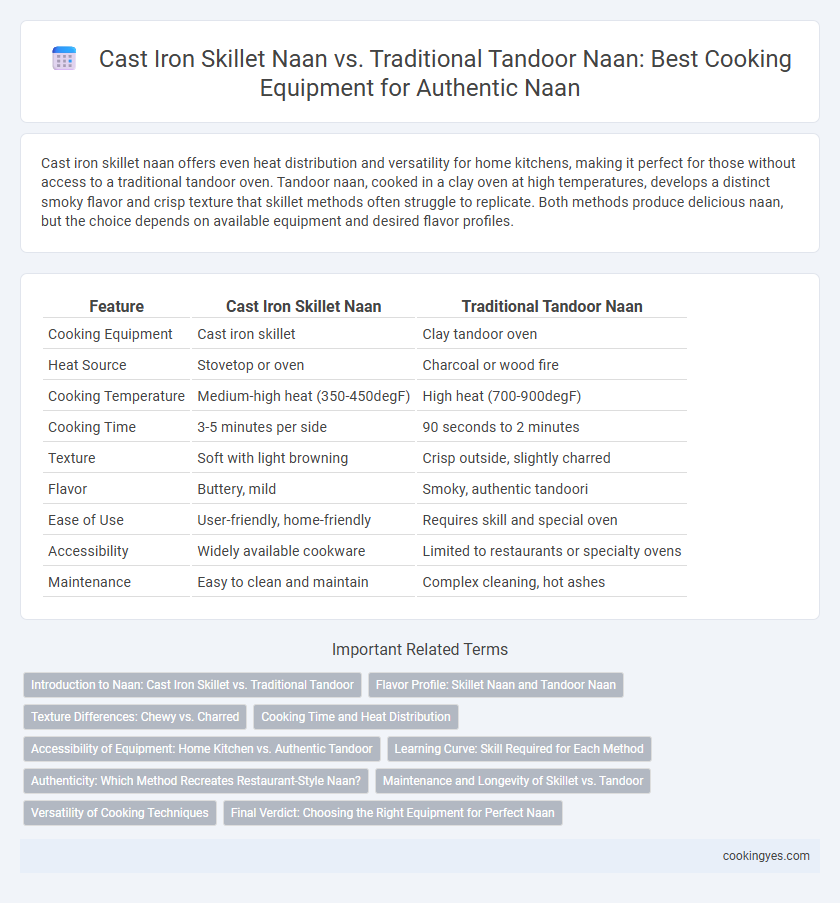Cast iron skillet naan offers even heat distribution and versatility for home kitchens, making it perfect for those without access to a traditional tandoor oven. Tandoor naan, cooked in a clay oven at high temperatures, develops a distinct smoky flavor and crisp texture that skillet methods often struggle to replicate. Both methods produce delicious naan, but the choice depends on available equipment and desired flavor profiles.
Table of Comparison
| Feature | Cast Iron Skillet Naan | Traditional Tandoor Naan |
|---|---|---|
| Cooking Equipment | Cast iron skillet | Clay tandoor oven |
| Heat Source | Stovetop or oven | Charcoal or wood fire |
| Cooking Temperature | Medium-high heat (350-450degF) | High heat (700-900degF) |
| Cooking Time | 3-5 minutes per side | 90 seconds to 2 minutes |
| Texture | Soft with light browning | Crisp outside, slightly charred |
| Flavor | Buttery, mild | Smoky, authentic tandoori |
| Ease of Use | User-friendly, home-friendly | Requires skill and special oven |
| Accessibility | Widely available cookware | Limited to restaurants or specialty ovens |
| Maintenance | Easy to clean and maintain | Complex cleaning, hot ashes |
Introduction to Naan: Cast Iron Skillet vs. Traditional Tandoor
Naan, a staple in Indian cuisine, traditionally bakes in a tandoor, a clay oven that reaches high temperatures, producing a unique smoky flavor and characteristic charred spots. Cast iron skillet naan offers a convenient alternative for home cooks, providing even heat distribution and a crispy exterior without the need for specialized equipment. While tandoor-cooked naan delivers authentic texture and taste, skillet naan allows for quick preparation and versatility in any kitchen setting.
Flavor Profile: Skillet Naan and Tandoor Naan
Cast iron skillet naan develops a slightly smoky, charred crust with a soft, chewy interior, enhancing the buttery and garlic-infused flavors due to even heat distribution. Traditional tandoor naan features intense smoky and charred notes from high-temperature clay oven cooking, producing a distinctive crispness and airy texture unique to the tandoor's environment. Both methods impart rich, complex flavors, but tandoor naan offers a more authentic smoky aroma compared to the skillet's subtler char and tenderness.
Texture Differences: Chewy vs. Charred
Cast iron skillet naan offers a chewy texture with a slightly crispy exterior, achieved through even heat distribution on the skillet's surface. Traditional tandoor naan develops a distinct charred texture, characterized by smoky, blistered spots from the intense, direct heat of the clay oven. The tandoor method imparts a unique flavor profile and crunch, while skillet naan provides a softer, more uniform bite.
Cooking Time and Heat Distribution
Cast iron skillet naan cooks faster due to its ability to retain and evenly distribute heat, ensuring a crispy exterior and soft interior in minutes. Traditional tandoor naan benefits from extremely high, direct radiant heat, causing rapid puffing and characteristic charring within seconds. While tandoor ovens offer superior heat intensity for authentic texture, cast iron skillets provide a practical alternative with consistent heat distribution and reduced cooking time.
Accessibility of Equipment: Home Kitchen vs. Authentic Tandoor
Cast iron skillet naan offers greater accessibility for home kitchens due to the widespread availability of the skillet and ease of use on standard stovetops. Traditional tandoor naan requires specialized clay ovens that generate high, even heat necessary for authentic texture and flavor but are often impractical for residential settings. The cast iron method replicates some characteristics of tandoor cooking while catering to everyday home cooks seeking convenience without sacrificing quality.
Learning Curve: Skill Required for Each Method
Cooking naan in a cast iron skillet requires moderate skill, emphasizing control over heat distribution and timing to achieve a chewy texture and slight charring. Traditional tandoor naan demands advanced expertise to manage extremely high temperatures and quick cooking times, producing a uniquely smoky flavor and characteristic blistered surface. Mastery of tandoor techniques often takes years, while skillet naan offers a more accessible learning curve for home cooks seeking authentic results.
Authenticity: Which Method Recreates Restaurant-Style Naan?
Tandoor ovens cook naan at extremely high temperatures, imparting a smoky flavor and characteristic charred spots critical to authentic restaurant-style naan. Cast iron skillets offer convenience and even heating but often lack the intense heat and smoky nuances that define traditional tandoor-cooked naan. For true authenticity and replication of restaurant-quality texture and taste, the tandoor remains the superior cooking method.
Maintenance and Longevity of Skillet vs. Tandoor
Cast iron skillet naan offers easier maintenance with simple cleaning and seasoning to prevent rust, ensuring long-term durability for home use. Traditional tandoor naan requires regular clay lining repairs and careful soot removal, making upkeep more labor-intensive but essential for authentic texture. The skillet provides consistent heat and longevity with minimal effort, while tandoor ovens demand specialized maintenance to preserve their high-heat cooking properties over time.
Versatility of Cooking Techniques
Cast iron skillet naan offers exceptional versatility by allowing precise temperature control and compatibility with various heat sources, including stovetops and ovens, enabling a wide range of cooking techniques. Traditional tandoor naan relies on high, radiant heat from clay ovens, delivering distinct char and smoky flavors unattainable with other methods. Combining cast iron skillet versatility with traditional tandoor insights can enhance naan texture and authenticity in home cooking environments.
Final Verdict: Choosing the Right Equipment for Perfect Naan
Cast iron skillet naan offers precise temperature control and even heat distribution, resulting in a crispy exterior and soft interior, ideal for home kitchens without access to a tandoor. Traditional tandoor naan provides authentic smoky flavor and superior charring due to its intense, radiant heat, which is difficult to replicate in skillet cooking. Selecting the right equipment depends on balancing convenience and authenticity, with cast iron skillets delivering versatility and tandoors excelling in producing genuine naan texture and taste.
Cast Iron Skillet Naan vs Traditional Tandoor Naan for cooking equipment Infographic

 cookingyes.com
cookingyes.com